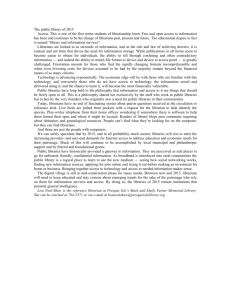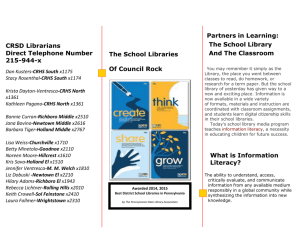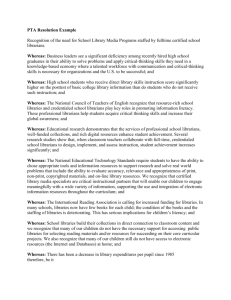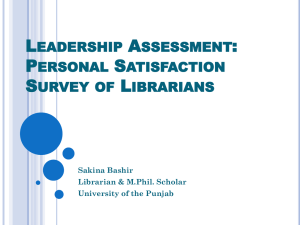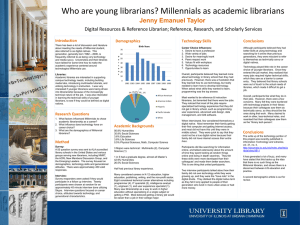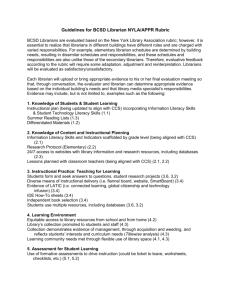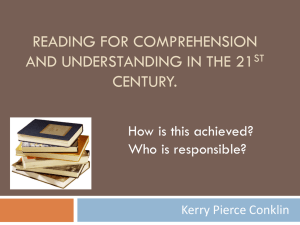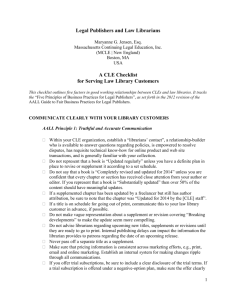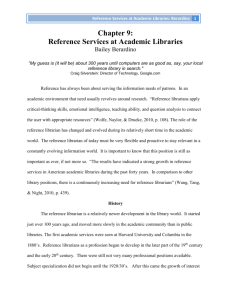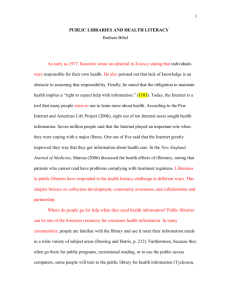Strengths and opportunities for improvement Library Department
advertisement
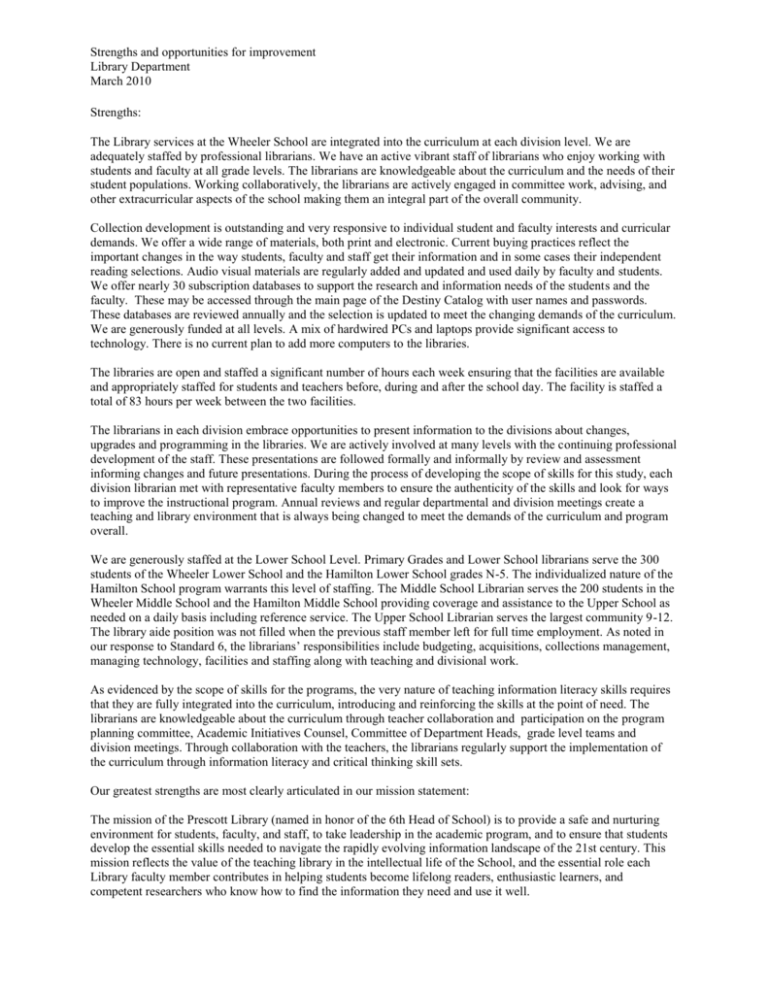
Strengths and opportunities for improvement Library Department March 2010 Strengths: The Library services at the Wheeler School are integrated into the curriculum at each division level. We are adequately staffed by professional librarians. We have an active vibrant staff of librarians who enjoy working with students and faculty at all grade levels. The librarians are knowledgeable about the curriculum and the needs of their student populations. Working collaboratively, the librarians are actively engaged in committee work, advising, and other extracurricular aspects of the school making them an integral part of the overall community. Collection development is outstanding and very responsive to individual student and faculty interests and curricular demands. We offer a wide range of materials, both print and electronic. Current buying practices reflect the important changes in the way students, faculty and staff get their information and in some cases their independent reading selections. Audio visual materials are regularly added and updated and used daily by faculty and students. We offer nearly 30 subscription databases to support the research and information needs of the students and the faculty. These may be accessed through the main page of the Destiny Catalog with user names and passwords. These databases are reviewed annually and the selection is updated to meet the changing demands of the curriculum. We are generously funded at all levels. A mix of hardwired PCs and laptops provide significant access to technology. There is no current plan to add more computers to the libraries. The libraries are open and staffed a significant number of hours each week ensuring that the facilities are available and appropriately staffed for students and teachers before, during and after the school day. The facility is staffed a total of 83 hours per week between the two facilities. The librarians in each division embrace opportunities to present information to the divisions about changes, upgrades and programming in the libraries. We are actively involved at many levels with the continuing professional development of the staff. These presentations are followed formally and informally by review and assessment informing changes and future presentations. During the process of developing the scope of skills for this study, each division librarian met with representative faculty members to ensure the authenticity of the skills and look for ways to improve the instructional program. Annual reviews and regular departmental and division meetings create a teaching and library environment that is always being changed to meet the demands of the curriculum and program overall. We are generously staffed at the Lower School Level. Primary Grades and Lower School librarians serve the 300 students of the Wheeler Lower School and the Hamilton Lower School grades N-5. The individualized nature of the Hamilton School program warrants this level of staffing. The Middle School Librarian serves the 200 students in the Wheeler Middle School and the Hamilton Middle School providing coverage and assistance to the Upper School as needed on a daily basis including reference service. The Upper School Librarian serves the largest community 9-12. The library aide position was not filled when the previous staff member left for full time employment. As noted in our response to Standard 6, the librarians’ responsibilities include budgeting, acquisitions, collections management, managing technology, facilities and staffing along with teaching and divisional work. As evidenced by the scope of skills for the programs, the very nature of teaching information literacy skills requires that they are fully integrated into the curriculum, introducing and reinforcing the skills at the point of need. The librarians are knowledgeable about the curriculum through teacher collaboration and participation on the program planning committee, Academic Initiatives Counsel, Committee of Department Heads, grade level teams and division meetings. Through collaboration with the teachers, the librarians regularly support the implementation of the curriculum through information literacy and critical thinking skill sets. Our greatest strengths are most clearly articulated in our mission statement: The mission of the Prescott Library (named in honor of the 6th Head of School) is to provide a safe and nurturing environment for students, faculty, and staff, to take leadership in the academic program, and to ensure that students develop the essential skills needed to navigate the rapidly evolving information landscape of the 21st century. This mission reflects the value of the teaching library in the intellectual life of the School, and the essential role each Library faculty member contributes in helping students become lifelong readers, enthusiastic learners, and competent researchers who know how to find the information they need and use it well. Strengths and opportunities for improvement Library Department March 2010 To fulfill this mission, the Library faculty will: Promote reading, provide thoughtful, unbiased suggestions of materials, and encourage intellectual curiosity. Collaborate in the teaching process and develop an information literacy curriculum that is integral to the classroom work of Wheeler faculty. Participate in school-wide and multi-school events that connect students with literature and ideas. Areas for improvement: The Middle School library program, while generously funded for material and technology is significantly under served in terms of square footage compared to the other division libraries at Wheeler. Lower and Middle School libraries are still very much about place as well as product. Independent reading is a corner stone of these programs and the fiction collections reflect the diverse reading interests and abilities at these levels. Research is taught in terms of defining tasks and the subsequent steps to find and effectively use information in all of its forms. There are still opportunities to practice using the catalog to find a book, the table of contents to determine its usefulness and keywords to find information in the book using the index. As a result, a robust fiction and non-fiction collection should still be a focal point of middle school library service. Middle School students have immediacy to their information and reading needs that would be best served with a geographic proximity to the students. The Middle School as stake holders in the MS/US library currently have an attractive comfortable tower room designated for their use. In contrast to the actual square footage of the MS/US library it is small and continues to be shared with the MS/US audio visual collection. A library adjacent to the Middle School computer lab would create an information center that would address the space, information and reading needs of the Middle School population and more appropriately align with the space and program commitments in the other division libraries. At the current time, we do not have a strategic plan to inform decisions over the course of the next 5-10 years relative to the changing face of library service especially in the Upper School Program. Accessing and effectively using information is no longer defined by capital investment in books and print sources. It is defined by the renewable expenditures for digital information characterized by audio files, ebooks and databases. This redefinition requires a clear plan for development to most appropriately meet this changing dynamic.
